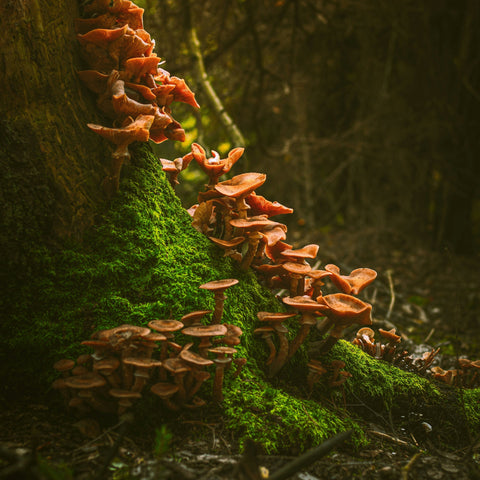My favourite season has arrived. As the air grows crisp and the leaves fall in a golden carpet across Britain’s woods and fields, something curious stirs in the undergrowth. Mushrooms push their way through moss and leaf litter, small worlds of wonder rising overnight. For generations, these autumnal arrivals have captured the imagination, inspiring folklore, myths, and whispered tales that still cling to our hedgerows and woodlands today.

Circles of Mystery - What is a fairy ring?
In British folklore, mushrooms and toadstools appear in some of the earliest stories and superstitions tied to the land. Records from medieval texts describe fairy rings as places where the Good Folk danced, and by the seventeenth century writers were already linking the red-capped fly agaric with enchantment and danger. Closer to home, the vivid red fly agaric has long featured in European myths and stories, often tied to spirits and the Otherworld.
One of the most famous images tied to fungi is the fairy ring. Across the British Isles, people believed these perfect circles of mushrooms marked places where fairies had danced under the moonlight. To step inside was thought to be dangerous, for it might whisk you away into the 'Otherworld'. While we now know fairy rings are formed by the growth pattern of certain fungi, the sense of magic lingers. Next time you come across one, it is hard not to feel a tingle of ancient enchantment.

Toadstools and Trickery
The red-capped fly agaric, with its white speckles, might be the most iconic mushroom in folklore. Often drawn in children’s books and painted onto autumn decorations, it has a darker reputation in British tradition. Sometimes linked with witches or mischievous spirits, it was said to lure wanderers astray in the woods. Yet its beauty cannot be denied, a vivid reminder of how the natural world can feel both inviting and uncanny.
Why are fly agaric mushrooms linked to folklore?
The fly agaric is visually striking and has long been tied to magic in European traditions. In Britain, it symbolised trickery and enchantment, often appearing in fairy tales and myths as a dwelling place of spirits or fair folk.
Portents and Protectors
Mushrooms have long been seen as omens. In some parts of the UK, an unexpected flush of fungi near a home was thought to bring good fortune. In other tales, they warned of change, a signal from nature that the year was turning. Mushrooms also became linked with protection; some households would hang charms or keep fungi motifs nearby as a way of warding off unwanted spirits. These stories remind us of the deep bond between people and the cycles of nature.
Are mushrooms considered lucky or unlucky?
Both. In some regions mushrooms symbolised prosperity and good harvests, while in others they were seen as signs of mischief or bad omens. The meaning often depended on local belief.

How to Hunt for Mushrooms
In Britain, heading out into the woods during autumn is almost a rite of passage. People have long gone in search of fungi, not only to gather food but also to experience the mystery of nature’s hidden treasures. Today, mushroom hunting can be enjoyed as a way of connecting with folklore and landscape rather than collecting for the kitchen.
Look for the shapes, colours, and patterns that echo the old stories: a fairy ring nestled in the grass, a fly agaric glowing like a lantern beneath the trees, or clusters of delicate fungi pushing through moss. Carry a notebook or a camera instead of a basket and let the woods tell their stories. By treating mushroom hunting as folklore exploring, you bring home memories and images rather than uncertain harvests.
Can I eat mushrooms I find?
Unless you are an expert, it is safest to admire mushrooms without eating them. Many species look alike, and some are harmful. Instead, treat mushroom hunting as a chance to discover folklore, take photographs, and celebrate the season - unless you are professionally trained to forage of course!
Capturing the Perfect Mushroom Photograph
For many, photographing fungi is one of the joys of autumn. Mushrooms often grow in shaded places, so soft natural light on overcast days makes colours glow. Getting low to the ground allows you to see the world as if you were stepping into a storybook, capturing the toadstool’s world from a fairy’s perspective. Moss, fallen leaves, and dappled light add layers of atmosphere to your image.
Photographs of mushrooms are not only beautiful but also serve as your own folklore archive, a way of keeping seasonal memories alive. Share them in autumn posts, pair them with one of our autumnal zines, or enjoy them beside the warm glow of a candle. They become part of your seasonal ritual, weaving your own story with the land.
Autumn’s Gift of Wonder
Today, many of us walk through woodlands in autumn with a sense of wonder rather than fear. Mushrooms and fungi are a symbol of the season’s mystery, their fleeting lives echoing the turning of the year. They invite us to pause, to notice the quiet magic underfoot, and to carry that story-filled sense of the land back into our homes.Mushrooms thrive in damp, cool conditions. In Britain, autumn brings the perfect weather for fungi to appear, making them a seasonal marker of change and harvest.
If you are seeking a trip to a stunning autumnal landscape head on over to our travel guide.
Good luck on your next adventure and remember to stay safe and follow the local guidelines when exploring any forests! And never taste a mushroom without professional confirmation that it is safe for consumption!

